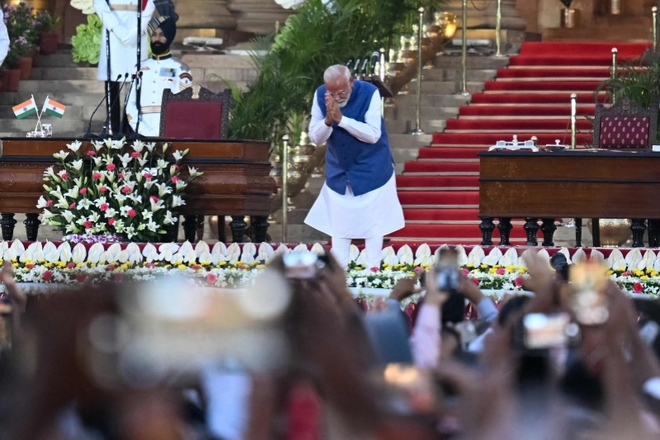How Effective is Modi’s Economic Policy? (AI Translation)
Listen to the full version


文|财新周刊 胡暄
By Caixin Weekly's Hu Xuan
“在我们的第三个任期内,印度将成为世界第三大经济强国。这是莫迪的保证。”2024年2月,以政治强人之姿执掌印度长达10年的总理莫迪,曾如此信心满满地展望未来5年的国家发展前景。
"In our third term, India will become the world's third-largest economy. This is Modi's promise." In February 2024, Prime Minister Modi, who has led India with a strongman approach for ten years, confidently outlined the country's development prospects for the next five years.
自2014年初次上台执政以来,莫迪以开启“印度的世纪”为号召,用10年的时间将印度打造成仅次于美国、中国、德国和日本的全球第五大经济体。走出疫情冲击的印度经济,亦以每年7%—8%的强劲增速,成为莫迪迄今三度连任的重要政绩支撑。凭着耀眼的经济数字,印度这个拥有14亿人口的南亚新兴市场,正愈发得到国际投资者的瞩目和青睐。
Since taking office for the first time in 2014, Prime Minister Narendra Modi has called for the dawn of the "Indian Century," aiming to transform India into the world's fifth-largest economy, trailing only the United States, China, Germany, and Japan within a decade. Emerging from the pandemic shock, the Indian economy has sustained a robust annual growth rate of 7% to 8%, providing significant support for Modi's three consecutive re-elections. With these striking economic figures, India, a burgeoning South Asian market with a population of 1.4 billion, is increasingly capturing the attention and favor of international investors.
然而,在6月初刚落幕的新一届印度大选中,莫迪领导的执政党印度人民党(下称“印人党”)虽然在盟友政党的支持下保住了组阁权,却失去了过去10年从未旁落的议会下院绝对多数地位。消息传出后,印度股市迅即暴跌,印度孟买SENSEX指数和印度NEFTY 50指数一度大跌超8%;这与一天前受印人党料将再获大胜的预期助推下,印度两大股指均上涨超过3%的走势形成鲜明对比。
However, in the newly concluded Indian general election in early June, the ruling Bharatiya Janata Party (BJP) led by Narendra Modi managed to retain the right to form a government with the support of allied parties. Yet, it lost the absolute majority in the Lok Sabha, a position it had held unchallenged for the past decade. Following the announcement, Indian stock markets plummeted sharply. The BSE Sensex and the NIFTY 50 indices both tumbled over 8% at one point. This was in stark contrast to the previous day's performance, where both indices had surged more than 3% amid expectations of another landslide victory for the BJP.

- DIGEST HUB
- Modi plans to make India the world's third-largest economy in his third term, capitalizing on the country's robust GDP growth of 7-8%.
- The BJP retained the right to form a government but lost its absolute majority, causing Indian stock markets to drop sharply.
- Despite significant economic progress under Modi, challenges like high youth unemployment, social inequality, and reliance on imported electronics components persist.
In India's 2024 general elections, Prime Minister Narendra Modi's Bharatiya Janata Party (BJP) won enough seats to form a government in coalition with allies but lost its absolute majority in the Lok Sabha, causing market volatility [para. 3]. This poses a new challenge for Modi, who must now navigate governance with more compromises and cooperation [para. 5]. Modi, who has been in power since 2014, aims to make India the third-largest global economy, building on a decade of 7-8% annual growth rates [para. 2][para. 7].
During his tenure, Modi has propelled the "Make in India" initiative, supported by tax reforms and substantial infrastructure investments, though challenges like high youth unemployment and social inequality persist [para. 10][para. 11]. India's economy has rebounded impressively since the COVID-19 pandemic, recording 8.2% growth in the fiscal year 2023-2024, surpassing expectations [para. 13][para. 14].
However, the post-pandemic recovery has been uneven, showing a "K-shaped recovery" where high-income groups thrive while lower-income groups struggle [para. 21]. Modi's ambitious "Developed India 2047" vision aims for India to be a developed nation by its 100th independence anniversary [para. 16].
Despite significant investments, India still lacks a strong domestic supply chain, essential for the "Make in India" initiative, especially in electronics manufacturing [para. 36]. Apple has increased its production in India, yet the country remains heavily dependent on imports for components like semiconductors [para. 38][para. 39].
Critics like Raghuram Rajan argue that India’s significant subsidy-driven manufacturing efforts might not be the optimal development path, suggesting an alternative focus on its strong services sector [para. 42][para. 43]. The discrepancies in the labor market show India's struggle to elevate a large portion of its population from low-income sectors to more productive and high-income jobs [para. 61][para. 66].
Observers note that the BJP's defeat in key states like Uttar Pradesh in the recent elections highlights persistent issues like unemployment and income inequality [para. 26][para. 27]. Despite these challenges, Modi's government remains focused on making transformative reforms, although the new coalition dynamics may slow down policymaking processes [para. 74][para. 78].
India must address its trade and investment deficits, as private investment in manufacturing has been sluggish post-pandemic [para. 58]. The country’s vast young labor force presents a demographic dividend, but converting this into a workforce skilled for manufacturing remains a significant hurdle [para. 72][para. 75]. Critics also argue that India’s education system and labor policies need substantial reforms to better equip the labor force for future economic demands [para. 64][para. 67].
In terms of infrastructure, India has seen substantial advancements, such as expanding its national highways and modernizing its rail system, yet these are primarily driven by government investments [para. 46][para. 50]. The challenge lies in balancing fiscal deficits while continuing necessary infrastructure investments [para. 51][para. 55].
The future of Modi's economic reform agenda in his third term hinges on navigating a coalition government and leveraging India's demographic and industrial potential to build a more inclusive and robust economy [para. 73][para. 80].
- 2014:
- Prime Minister Narendra Modi takes office for the first time, calling for the dawn of the 'Indian Century.'
- 2017:
- India implements a nationwide Goods and Services Tax (GST).
- 2018 to 2022:
- The average speed of Indian freight trains increased by 62.2%.
- 2018-2019 fiscal year:
- Indian government's capital expenditure is 3.1 trillion rupees.
- 2020-2021 fiscal year:
- India experiences a 5.8% negative growth due to the COVID-19 pandemic.
- After 2020-2021 fiscal year:
- Indian economy rebounds with growth rates of 9.7% and 7% for the following two fiscal years.
- 2021-2022 fiscal year:
- Logistics costs in India accounted for approximately 7.8% to 8.9% of GDP, a decrease from a decade ago.
- May 31, 2024:
- India's Ministry of Statistics and Programme Implementation releases economic data showing an 8.2% economic growth rate for the 2023-2024 fiscal year.
- June 5, 2024:
- Official election results announced with BJP securing 240 seats.
- June 7, 2024:
- Modi attended a House of the People session and responded to opposition criticisms.
- June 9, 2024:
- Narendra Modi takes the oath of office for his third term as Prime Minister of India.
- GALLERY
- PODCAST
- MOST POPULAR





 Sign in with Google
Sign in with Google
 Sign in with Facebook
Sign in with Facebook
 Sign in with 财新
Sign in with 财新